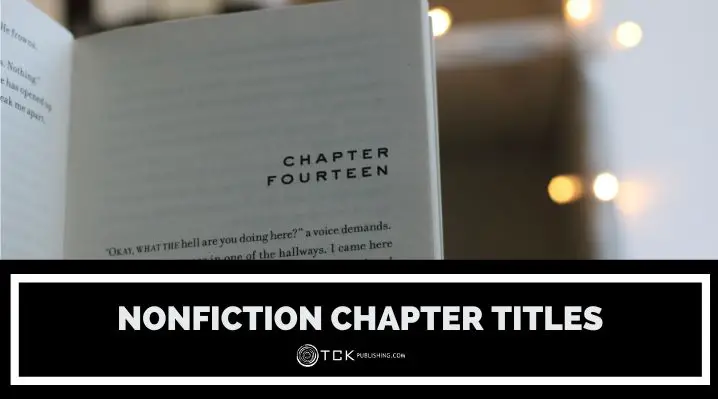
Chapter titles play a role in your book’s success. They give hints to your readers on what a particular chapter is about as well as entice them to read it.
You’ll likely spend a lot of time concocting the perfect titles for each of your chapters. You want them to be just as engaging as the one on your front cover. Make them too creative though, and you risk losing your readers’ attention.
How to Write Nonfiction Chapter Titles
Here are some tips on writing engaging chapter titles that get your audience in the mood for reading.
1. Consider if you need a chapter title.
A lot of writers opt to number their chapters instead. Not because they lack creativity, but for pacing and simplicity.
It’s a straightforward way of structuring your book. You keep the pace by giving away nothing, forcing your readers to immediately jump into the next chapter. This works well for fast-paced narratives.
You can also do it for functional reasons. A numbered chapter is easy to remember and find if your readers ever lose their place in the book. Numbers are also universally understood. It may also fit your book’s format, style, genre, and tone better.
2. Keep it simple.
Sometimes simple is best. If you make your chapter title too intriguing, your readers will ask why chose it.
Keep in mind that chapters need to flow into each other. You break that flow by making your readers go back and forth in your book, trying to figure out your title’s message.
You want your titles to be creative enough to tickle your readers’ minds but not enough to make them fully stop reading. And if they’re looking at your table of contents, they should be able to glean some information about the chapter.
This means no overly poetic titles such as “Reflections in the Sands of Time” when you can just write “Lessons from History.” And don’t force a pun if it’s too awkward or complicated to get in a flash.
3. Decide on your titles last.
Many writers are guilty of creating their titles before writing the actual prose. Sometimes that’s not the best move! You unintentionally fixate on the title and spend your time making sure the prose fits it instead of vice versa.
Leave naming your chapters for last and use placeholders for now. Only think of a permanent title when you’ve already written the chapter’s contents.
4. Analyze chapter contents.
Read through your chapter and find its main point. Jot down all the keywords, main points, and themes. Maybe even write a summary for each chapter.
From there, pick out the first thing that needs to be communicated to your readers. For example, a chapter could be dedicated to “saving money” but approaches that idea through cutting costs. “Cutting Costs” is then a better keyword for the title.
5. Mind mapping.
Mind mapping is a visual technique used to connect themes and key points. Start with a central idea, then branch out with related ideas.
This helps you make connections and come up with a title that reflects your chapter’s contents.
6. Use power words and active voice.
Power words are persuasive and descriptive words. Use them to trigger an emotional response from your audience and make them act.
Active voice is where the subject does an action. It is clear, straightforward, and uses fewer words compared to the passive voice.
Combining both gives you a title that easily conveys meaning to your readers and entices them to continue reading.
Even a one-word title hits hard if you use the correct word. For example, “War” is so short but extremely evocative.
7. Use questions or provocative statements.
A chapter title’s primary use is to spark curiosity. Asking your readers a question or using provocative statements will make your readers want to find out more.
So instead of “Benefits of Meditation”, try “Why Meditate and Save Your Life?” instead. It’s more compelling while still providing context about the chapter.
However, these questions need to be relevant to the chapter contents. It’s your responsibility to fulfill the curiosity you sparked. The readers are there to learn from you, not to be left hanging.
8. Do A/B testing.
A/B testing involves comparing two versions of your title to see which one performs better. You can do this by sharing the two options on your platforms.
Ask your audience to vote for their favorite. Most social media platforms have a built-in poll function to make it easier for you. Or, if you want more detailed feedback, you can use tools like Google Forms to collect responses.
9. Use a summary for a title.
A summary can be as short as a sentence. Inversely, the shorter your summary, the less details you provide. Use this to your advantage.
Think of a short sentence that condenses your chapter’s contents well. For example, you’re writing a chapter about your first fight with your mother and both of you said harsh words. “I Told My Mom I Hated Her and Vice Versa”, could be a good chapter title.
It provides some context while also raising multiple, urgent questions. There was a fight. You both said hurtful words to each other. Did you regret it? Who was at fault? Did this have a permanent effect on your relationship with your mother?
Why Chapter Titles Matter
Chapter titles are more than just labels. They draw your audience in, give them a glimpse of what’s to come, and keep them asking for more.
Great chapter titles have certain traits in common. They are easy to understand, relevant to the chapter’s contents, and consistent with your book’s overall feel. Think of them as a spice that adds something extra to your work.
However, they aren’t necessary nor should you spend too much time and effort making them. When you plan on writing chapter titles, you’re adding pressure on yourself. That pressure multiplies the more chapters you have.
So think about whether you need them in your work first. If you do, only work on them once you’re done with your book’s contents.
Do you use chapter titles in your books? Share your thoughts below!
If you enjoyed this post, then you might also like:
- How Long Should a Chapter Be? Tips for Finding the Right Breaks in Your Book
- How to Use Chapter Breaks: Tips for Effectively Breaking Down Your Novel
- How to End Your Book: 5 Steps to Writing a Fantastic Final Chapter
- How to Write the First Chapter of a Book: A Checklist for Novelists

Cole is a blog writer and aspiring novelist. He has a degree in Communications and is an advocate of media and information literacy and responsible media practices. Aside from his interest in technology, crafts, and food, he’s also your typical science fiction and fantasy junkie, spending most of his free time reading through an ever-growing to-be-read list. It’s either that or procrastinating over actually writing his book. Wish him luck!
